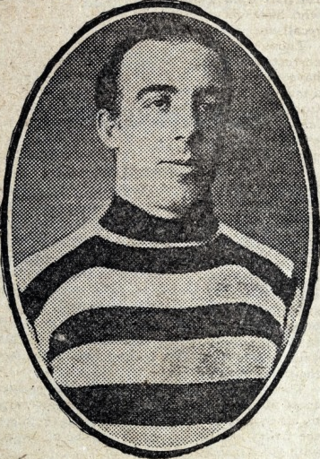Related Research Articles

William Joseph Lincoln was an Australian playwright, theatre manager, film director and screenwriter in the silent era. He produced, directed and/or wrote 23 films between 1911 and 1916.

John F. Gavin was a pioneer Australian film actor and director, one of the early filmmakers of the 1910s. He is best known for making films about bushrangers such as Captain Thunderbolt, Captain Moonlite, Ben Hall and Frank Gardiner. Known informally as 'Jack', Gavin worked in collaboration with his wife Agnes, who scripted many of his films.

Arthur "Jack" Verge was a rugby union player who represented Australia, New South Wales and Sydney University. Playing as a fullback, Verge won both his caps for Australia in 1904 against a touring team from the British Isles. Although he was relatively light for his position, he was repeatedly praised for his tackling and all-round defensive work, and in attack, he was a fast and deceptive runner. His kicking, on the other hand, was inconsistent.
Ben Hall and his Gang is a 1911 Australian film about the bushranger Ben Hall, played by John Gavin, who also directed. It is considered a lost film.

Alfred Rolfe, real name Alfred Roker, was an Australian stage and film director and actor, best known for being the son-in-law of the celebrated actor-manager Alfred Dampier, with whom he appeared frequently on stage, and for his prolific output as a director during Australia's silent era, including Captain Midnight, the Bush King (1911), Captain Starlight, or Gentleman of the Road (1911) and The Hero of the Dardanelles (1915). Only one of his films as director survives today.
The Crisis is an Australian melodrama film directed by W. J. Lincoln. It was inspired by a painting, The Crisis by Frank Dicksee, and is considered a lost film.
Robbery Under Arms is a 1907 Australian silent western/drama film based on the 1888 novel by Rolf Boldrewood about two brothers and their relationship with the bushranger Captain Starlight. It was the first film version of the novel and the third Australian feature ever made.
The Life of Rufus Dawes is a 1911 Australian silent film based on Alfred Dampier's stage adaptation of the 1874 novel For the Term of His Natural Life produced by Charles Cozens Spencer.

The Lady Outlaw is a 1911 Australian silent film set in Van Diemen's Land during convict days.
Do Men Love Women? is a 1912 Australian silent film directed by Alfred Rolfe about an alcoholic who reforms through the love of a good woman. The finale featured a railway collision.
Cooee and the Echo is a 1912 Australian silent film directed by Alfred Rolfe. It is considered a lost film.
Won on the Post is a 1912 Australian silent film directed by Alfred Rolfe set against a backdrop of horseracing.
Moira, or The Mystery of the Bush is a 1912 Australian silent film directed by Alfred Rolfe.
The Five of Hearts is a 1911 Australian film from Edward Irham Cole based on a stage play about Buffalo Bill which Cole had performed extensively. It is also known as A Maiden's Distress or Buffalo Bill. It was reportedly the longest of Cole's films.
Gambler's Gold is a 1911 Australian film based on the 1911 novel by Arthur Wright. It is considered a lost film.

Dan Morgan is a 1911 Australian film from Charles Cozens Spencer about the bushranger Daniel Morgan. It was said to be starring "Alfred Rolfe and company". Rolfe directed three movies for Spencer, all starring himself and his wife Lily Dampier so there is a chance he may have directed this one and that it starred his wife. A prospectus for the Australian Photo Play Company said he directed it. It is considered a lost film.
The Shepherd of the Southern Cross is a 1914 Australian silent film about an Englishwoman torn between two men. It was the first feature film produced by Australasian Films.
The Opium Runners is a 1913 Australian silent film. It is considered a lost film.

The Goulburn to Sydney cycling race was a one-day road bicycle race. The first race was held in 1902 with the last in 2012.

Alexander Gordon Desmond Baird was an Australian rules footballer who played with South Melbourne and St Kilda in the Victorian Football League (VFL). He played a prominent part in the 1913 VFL Grand Final; his decision to handball in the final minutes, instead of shoot at goal, is often blamed as having cost St Kilda the premiership.
References
- 1 2 "Advertising". The Referee . Sydney. 6 August 1913. p. 16. Retrieved 9 June 2015– via National Library of Australia.
- ↑ "CORRIMAL". South Coast Times and Wollongong Argus . NSW. 24 October 1913. p. 14. Retrieved 9 June 2015– via National Library of Australia.
- ↑ "Stevenson,s star Pictures". The National Advocate . Bathurst, NSW. 11 February 1915. p. 2. Retrieved 9 June 2015– via National Library of Australia.
- ↑ "MOVING PICTURES". The Referee . Sydney. 27 August 1913. p. 16. Retrieved 9 June 2015– via National Library of Australia.